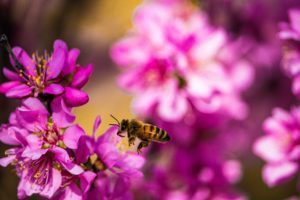Not all bees are bad bees, and honey bees are essential to pollination! The bugs that spread pollen from one part of the plant to the other are known as “pollinators.” Pollinators can include bugs, animals and even the wind! Most people think of honey bees, and we’ve partnered with the National Pest Management Association (NPMA) to educate the public and bolster the industry’s outlook on these insects!
Pollinators in fiction
In The Poisonwood Bible, the Price family moves to the Belgian Congo as missionaries. When they arrived, one of the first things they did was plant a garden to provide food for themselves and the village they resided in, but no matter how hard they tried, the garden would not produce any fruit. It took the characters a while, but eventually they figured it out. The garden wouldn’t produce fruit because there were no natural pollinators!
Pollinators in real life
Pollinators are an extremely important part of the food growing process. According to Penn State’s Department of Entomology, these insects carry pollen between the two reproductive parts of the plant. This allows the plant to produce other seeds and flowers which then leads to fruit. Without pollinators to help us, much of our produce section would be obsolete.
Penn State also pointed out the pollinator’s major role in the ecosystem. Pollinators enable plants to produce the nuts, berries, fruits, etc. that herbivores eat. The plants also need the pollinators to produce more seeds. Without them, plants would cease to exist, and without a food source, the herbivores would become extinct and predators wouldn’t have a food source which means they would also become extinct. As you can see, we need to preserve the pollinators to keep the ecosystem balanced.

How can I help the pollinators?
Create a pollinator garden
To create an oasis for a pollinator, plant flowers that are local to your region. If you’re unsure of what flowers those are, you can find a list of wildflowers by state here. If you wish to know more plants that aren’t wildflowers, you can consult your local nursery or an experienced gardener. Plants with lots of nectar and pollen are great. Next, plant these flowers in clusters. Big groupings of flowers are much more visible and noticeable to pollinators. Yellow, blue and purple flowers are especially attractive to bees. Finally, you should consider planting flowers with different bloom times. That way, the pollinators will have access to pollen and nectar year round.
It is important to note that these gardens should be a haven for pollinators like honey bees, but unless you are trained to handle bees like a beekeeper is, you should not allow stinging insects to take up residence on your property as it can prove to be very dangerous. If honey bees have taken up residence, contact a pest management professional with a bee removal and relocation program to take the bees off your property.
Become a beekeeper
After creating a pollinator garden to support your hive, you can become an apiarist or beekeeper! Just check with your local zoning officials that your yard has the clearance and space to support such activities. But we know the beekeeping life isn’t for everyone. Even so, buying honey and bee byproducts from your local beekeeper can help them support their beekeeping hobby or business. Beekeepers will sometimes partner with farmers to help them pollinate their crops and are responsible for creating products like soaps, lotions and candles.
Gregory and Pollinators
Did you know that Gregory is pollinator friendly? We have a honey bee removal and relocation program in the Upstate of South Carolina, and if your honey bee problem happens to be in another part of our service area, we will try to refer you to a local beekeeper or “apiarist” to remove and relocate the bees.
Matt Tancibok, one of our employees, has been very involved in getting the bee program up and running at Gregory. In order to become a “bee expert,” Tancibok has taken several bee classes, and is even responsible for bringing beekeeping classes here to Gregory! Thanks to Matt, Gregory has been able to partner with a local organic beekeeper to offer two cycles of beekeeping classes. Gary Wagner first got involved in beekeeping when he attended one of these classes. Both Tancibok and Wagner have hives in their backyards which is where Gregory has relocated some of the retrieved hives.
Matt’s and Gary’s experiences and skills allow them to give expert advice on honey bee issues. One day, we got a call from a commercial account. PCT Magazine’s Residential Technician of 2017, Gus Walker, arrived on the scene to find that honey bees were swarming around bushes. Since this was a commercial account, there is more foot traffic and a more immediate need to get the bees out before they sting someone. So Wagner made his way to the location, and with Gus Walker helping, he placed the bees, along with their queen, in a temporary cardboard box. Other bees followed and began to reorient around the queen in a ball shape. “Within the hour, the bees were placed into a colony and have acclimated well” Wagner stated.
Unfortunately, there are times when bee hives can’t be saved. They can be very dangerous to people with allergies, and it’s more important to keep our customers safe. Our primary concern is public safety, but we endeavor to preserve as many hives as possible.

